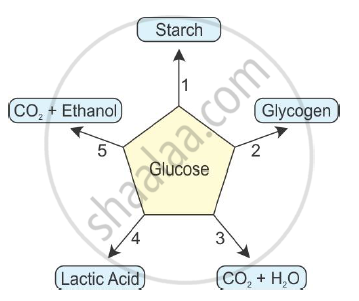Advertisements
Advertisements
प्रश्न
Fill in the Following Blank with Suitable Word.
_________ In the Lungs Provide a Very Large Surface Area for Gaseous Exchange.
उत्तर
Alveoli in the lungs provide a very large surface area for gaseous exchange.
APPEARS IN
संबंधित प्रश्न
Given below are the end products of different reactions involving glucose.

Write the reaction number in front of the following:
(i) Anaerobic reaction =
(ii) Reaction in the human muscles =
(iii) Aerobic respiration =
(iv) Reaction in the plant cells =
(v) Reaction in the liver
During heavy exercise, we get cramps in the legs due to the accumulation of ______.
Given below is a square of letters in which are hidden different words related to respiration in organisms. These words may be present in any direction − upwards, downwards, or along the diagonals. Find the words for your respiratory system. Clues about those words are given below the square.

- The air tubes of insects
- Skeletal structures surrounding chest cavity
- Muscular floor of chest cavity
- Tiny pores on the surface of leaf
- Small openings on the sides of the body of an insect
- The respiratory organs of human beings
- The openings through which we inhale
- An anaerobic organism
- An organism with tracheal system
Name an animal which depends on simple diffusion of gases for breathing.
Name the red pigment which carries oxygen in blood.
Fill in the following blank with suitable word:
Gills are the breathing organs in ___________.
State the three common features of all the respiratory organs like skin, gills and lungs.
A, B and C are three living organisms. The organism A is a unicellullar fungus which can live without air. It is used in the commercial production of an organic compound P from molasses. The organism B is a unicellular animal which lives in water and feeds and moves by using pseudopodia. It breathes through an organelle Q. The organism C is a tiny animal which acts as a carrier of malarial parasite. It breathes and respires through a kind of tiny holes R and air-tubes S in its body.
(a) What are organisms (i) A (ii) B, and (iii) C?
(b) Name (i) P (ii) Q (iii) R, and (iv) S.
(c) Which organism/organisms undergo aerobic respiration?
(d) Which organism/organisms undergo anaerobic respiration?
There are five animals P, Q, R, S and T. The animal P always lives in water and has gills for breathing. The animal Q can stay in water as well as on land and can breathe both, through moist skin and lungs. The animal R lives in soil and breathes only through its skin. The animal S lives on land and breathes through spiracles and tracheae. And animal T lives in water and breathes through its cell membrane.
(a) Which of the animals could be Amoeba?
(b) Which of the animals could be frog?
(c) Which animal could be fish?
(d) Which animal could be grasshopper?
(e) Which animal could be earthworm?
Fill in the following blanks with suitable words:
The ___________ blood cells make antibodies whereas ___________ blood cells help in respiration.
It has been found that people living in very high mountains have many more red corpuscles in their blood than people living in plains. Which one of the following best accounts for this phenomenon?
A student has set up "CO2 is released during respiration”. After about 1 hour he observes no change in the water level in the delivery tube. Write two possible resons for the failure of the experiment.
Name the body structure concerned with the given functional activity:
Transports oxygen to the body cells.
Given below is an example of certain structure and its special functional activity:
"Kidney and excretion".
Fill in the blanks on a similar pattern.
'C' shaped cartilage rings and ____________.
List the organs of Human respiratory system.
Complete the analogy.
Transport of CO2 by plasma : 7% :: Transport of CO2 by bicarbonate ions: ____________.
____________ is the maximum amount of air that the lungs can hold after a maximum forceful inspiration.
____________ is necessary for the respiration in plant.
Which of the following is an incorrect statement?
